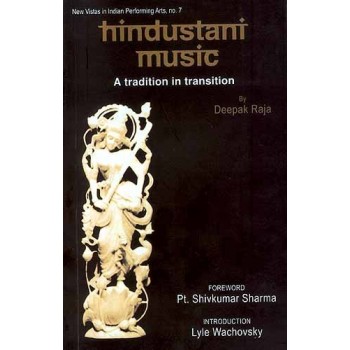Hindustani Music A Tradition in Transition
| Price: | Rs.790.00 |
Detail Of Hindustani Music A Tradition in Transition
| ISBN | 9788124608074 |
| Pages | 460 |
| Language: | English |
| Size(in cm): | 8.5" X 5.5" cm |
| Weight(in grams): | 695(approx) |
Description:
CONTENTS
Foreword VII
Preface XIII
Acknowledgements XXV
Key to Transliteration XXIX
Prologu 1
Not by Accident Alone 2
The Bigger Picture 3
The Language Issue 5
Issues of Objectivity 6
The Writer's Role 7
Towards Connoisseur Activism 9
Clarity of Purpose 11
Introduction 13
PART I
Culture, Technology and Economics
1.1 Populism and Rival Forces 25
The Emergence of a Market 26
Dimensions of Populism 27
The Conservationist Reaction 29
The Unlikely Ally 32
1.2 If Peanuts is What You Pay 36
The Changing Context 37
The Economics 38
The Bottom-line 41
1.3 Government, Business and Classical Music 42
The Traditional Patronage Model 42
Benefactor Qualifications 44
Reconfiguring Benefaction 47
1.4 Pandits and Ustads Aplenty 49
1.5 Archival Music and the Cultural Process 55
Obsolescence in Recorded Music 56
The Archival Music Market 57
Generations as "Markets" 59
Continuity and Change 61
The Challenge from the Graveyards 61
The Yardstick of Musicianship 64
The "Virtual Guru" 66
The Big Picture 69
1.6 A Requiem for the Gharanas 71
What is Gharana? 71
Favourable Conditions 73
The Golden Age of Hindustani Music 77
Chinks in the Armor 78
The Gharana "Brands" Today 81
PART II
Form, Idiom and Format
2.1 Architecture in Modern Hindustani Music 87
The Architectural Metaphor 88
Function and Structure 89
The Linearity of Progression 90
The Cyclicity of Melodic Exploration 93
The Econometric Model 96
A Case Study 97
The Duration Factor 99
The Argument 100
2.2 Instrumental Idioms Anga or Apanga 102
Source Material of the Hindustani Material 103
Adoption and Adaptation 104
Deviations and Innovations 105
Aucitya in Innovation 107
Aucitya - The Idea 110
2.3 The Jugalbandi Racket 111
Jugalbandi Patterns 112
The Burden of Evidence 113
Experimentation and Propriety 115
2.4 Tihayis and the Rape of Melody 117
The Logic of Tihayis 118
Placement, Function, and Aesthetics 120
The Aesthetic and the Grotesque 121
PART III
The World of Ragas
3.1 The Raga-ness of Ragas 125
The Melodic Grammar of Ragas 130
The Aesthetic Grammar of Ragas 133
3.2 Raga Chemistry and Beyond 138
The Allotrope 139
The Compound 141
The Emulsion 143
Chemistry Defines Options 145
The Raga-Malika 146
Beyond Chemistry 147
Raga Chemistry and you 149
3.3 Raga: Right and Wrong 150
Nomenclature 151
Rare Ragas and their Compounds 152
Creative License 153
Raga Evolution 154
Grammatical Propriety 156
The Bottom-Line 157
3.4 Kedara at Sunrise 159
The Theory 162
A Rational Perspective 165
3.5 The Experience of Melody: From Dhrupad to Santura 168
Melody in Dhrupad 169
Melody in Khayala 171
Melody on the Sitara 172
Melody on the Saroda 174
Melody on the Flute 175
Melody on the Santura 175
What the Trends Imply 176
The Concept of a Genre 178
The Concept of a Music-Scape 179
Alarm and Reassurance 182
PART IV
The Major Genres
4.1 An Introduction to Dhrupad 185
An Aesthetic Perspective 188
Stylistic Diversity 189
Gharanas of Dhrupad 191
Melodic Expressions in Dhrupad 192
The Talas of Dhrupad 194
Raga Presentation Structure 195
Variants on the Raga Presentation Structure 199
The Ensemble for Dhrupad Performance 200
A Structural Analysis 201
The Nature of Appeal 202
Dhrupad Today 204
4.2 An Introduction to Khayala 207
The Plastic Arts Metaphor Applied to Khayala Music 208
History and Evolution 209
The Gharanas of Khayala Music 210
The Ensemble for Khayala Performance 213
The Format of Khayala Presentation 213
Melodic Expressions in the Khayala Genre 215
The Poetic Element in the Khayala Vocalism 217
Articulation in Khayala Music 218
The Structure of Compositions 220
Khayala Presentation Protocol 220
The Typology of Tanas 222
The Aesthetics of Tanas 224
Trends in Khayala Vocalism 226
4.3 An Introduction to Thumari 229
Sources of the Thumari Tradition 231
Stylistic Evolution 232
Landmark Personalities 236
Poetry in Thumari 241
Ragas in Thumari 243
Tala in Thumari 244
Dadara, The Genre 245
Ensemble for Thumari Performances 246
Bandisa Thumari: Structure and Rendition 246
Bola-banao Thumari: Structure and Rendition 248
Thumari in Instrumental Music 250
The Thumari Today 253
4.4 Introduction to the Tappa 257
Historical Outline 258
Salient Stylistic Features 261
The Tappa Today 263
PART V
The Major Instruments
5.1 The Rudra Vina 269
Organology 270
History 271
Design 274
Ergonomics 276
Acoustics 278
Stroke Craft 279
Techniques of Melodic Execution 280
Recent Bina Music 281
The Disappearing Breed 287
5.2 The Sitara 290
The Masit Khani Gata 291
The Raza Khani Gata 292
Sitara Styles 293
Techniques of Melodic Execution 294
The Singing Sitara 295
5.3 The Surabahara 298
Surabahara and the Imdad Khan Lineage 300
5.4 The Saroda 303
History 303
Organology 305
Design and Tuning 306
Acoustics 307
Ergonomics 307
The Saroda Idiom 309
Techniques of Melodic Execution 309
New Path to Sculpting of Melody 311
5.5 The Santura 314
Organology 315
Construction and Tuning 317
Evolutionary Perspectives 318
Shiv Kumar Sharma's Music 321
The Santura after Shiv Kumar Sharma 324
5.6 The Sehnayi 328
Organology 328
Design 329
Idiom and Repertoire 330
Genres in Sehnayi Music 331
The Ensemble for Sehnayi Performances 332
The Disappearing Sehnayi 332
5.7 The Sarangi 334
Construction, Design, and Tuning 335
Playing Technique 336
The Role of the Sarangi in Music 336
The Harmonium Challenge and the Response 338
The Sarangi - As the Second Fiddle and the First 340
5.8 The Indian Classical Guitar 343
Evolutionary Perspectives 344
The Vicitra Vina Legacy 346
Kabra's Guitar 347
After Kabra 349
Glossary 351
Suggested Bibliography 419
Index 423
Reviews (0)
Write a review
Your Name:Your Review:
Note: HTML is not translated!
Rating: Bad Good
Enter the code in the box below:



 |
| 